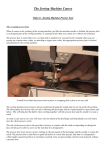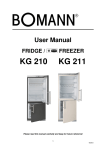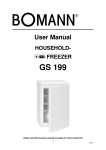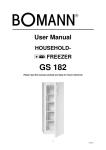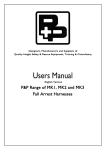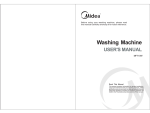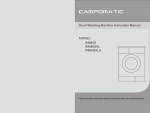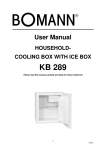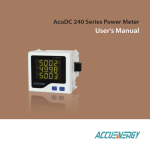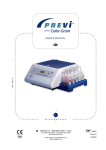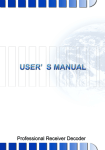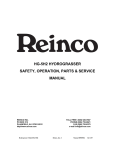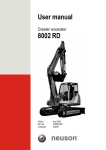Download install washing machine
Transcript
User Manual WASHING MACHINE WA 9310.1 Please read this manual carefully and keep for future reference! 1 05/2012 TABLE OF CONTENT OVERVIEW DISPOSAL OF USED DEVICES SAFETY PRECAUTIONS OVERVIEW OF WASHING MACHINE / TECHNICAL SPECIFICATIONS INSTALL WASHING MACHINE OPERATE WASHING MACHINE TABLE OF WASHING PROCEDURES CARE AND MAINTENANCE TROUBLE SHOOTING REMOVE THE PROBLEMS 2 2 2 4 5 7 11 11 13 14 OVERVIEW Thank you for choosing this washing machine. This user manual contains important information for installation, operation and maintenance. Please read all instructions carefully, so that you can make use of all functions and the washing machine is kept in good order. The warranty does not cover defects due to overstraining, improper use or maintenance. Please keep all documents in a safe place for future reference. If you have any doubt, please contact the nearest authorized service center or your distributor. DISPOSAL OF USED DEVICES This product is marked in accordance with the European waste regulation 2002 / 96 / EC - WEEE It regulates the proper disposal of the product. Environmentally friendly disposal will prevent possible negative consequences to health caused by improper disposal. This symbol on the product or its packaging indicates that this product must not be disposed of with the regular household waste. The user has to return the product to a collection point for the recycling of electric and electronic equipment. The disposal must comply with the local regulations in place. For further information please contact your local authorities or waste collection service. Disable waste equipment before disposal: - Disconnect the mains plug from the wall socket. - Disconnect the plug from the mains cable. - Remove or disable any existing spring or latch locks. This will prevent children from locking themselves (risk of suffocation!) or from getting into perilous situations. Children might not understand the risks that arise from handling household devices. Therefore, observe children and make sure they do not play with the device. Environmental protection - Do not use excessive detergents. - Decontaminant and bleacher can be used to pre-treat the stains on the clothes only when very necessary. SAFETY PRECAUTIONS ■ - Before operating this machine Packing materials may be dangerous to the kids. Please keep all packing materials (plastic bags, foams etc.) far away from the kids. Do not install the washing machine in close proximity of explosive and caustic gases. Make sure that the water and electrical devices must be connected by a qualified technician in accordance with the manufacturer's instructions (refer to page 5 "Install Washing Machine”) and local safety regulations. 2 05/2012 - ■ - - ■ - Before operating this machine, all packages and transport bolts must be removed. Otherwise, the washing machine may be seriously damaged while washing the clothes (refer to page 5 "Remove Transport Bolts"). Before washing the clothes at first time, the washing machine shall be operated in one round of the whole procedures without the clothes inside (refer to page 9 "Washing Clothes at First Time"). This washing machine is for indoor use only. Safety cautions Pull out its plug from the power socket before cleaning or maintenance, Make sure that all pockets are emptied. Sharp and rigid items such as coin, brooch, nail, screw or stone etc. may cause serious damages to this machine. Pull out its plug and cut off water supply after the operation. Please check whether the water inside the drum has been drained before opening its door. Please do not open the door if there is any water visible. Glass door may be very hot during the operation. Keep kids and pets far away from the machine during the operation. This machine is not intended for use by persons (including kids) with reduced physical, sensory or mental capabilities, or lack of experience and knowledge, unless they have been given supervision and/or instruction concerning use of the machine by a person responsible for their safety. Children must be supervised to ensure that they are not playing with the appliance. Do not try to repair the machine by yourself. The machine may be damaged or more troublesome repair work may be caused and even dangerous operation may take place if it is repaired by any inexperienced or unqualified staff. To avoid danger a damaged mains cord (or plug) must be exchanged by the authorized technician. Take care that power voltage and frequency is identical with the rating label. Do not use any socket with rated current less than that of washing machine. Never pull out power plug with wet hand. To ensure your safety, power cord and plug must be inserted into an earthed three-pole socket. Check carefully and make sure that your socket is properly and reliably earthed. This machine shall be repaired only by an authorized technician and only authentic accessories can be used. Cautions when washing clothes Connect to cold tap water. Only in this way cold washing cycles can be achieved. Your washing machine is only for home use and is only designed for the textiles suitable for machine washing. Inflammable and explosive or toxic solvents are forbidden. Do not use detergents containing gasoline or alcohol. Only use detergents for washing machines. We do not recommend washing carpets. Ensure that no children are playing with the washing machine and keep pets away. Be careful of burning when washing machine drains hot washing water. Never refill the water by hand during washing. After washing put off the device by pressing the On/Off button Please remember to disconnect water and power supply immediately after the clothes are washed. ■ - Attention shall be paid to protecting the machine Do not climb up and sit on top cover of the machine. Do not lean against machine door. Please do not close the door with excessive forces. If it is found difficult to close the door, please check if the excessive clothes are put in or distributed well. ■ - Cautions during handling machine Transport bolts shall be reinstalled to the machine by a specialized person. The accumulated water shall be drained out of the machine. Handle the machine carefully. Never hold each protruded part on the machine while lifting. Machine door can not be used as the handle during the conveyance. 3 05/2012 OVERVIEW OF WASHING MACHINE Detergent drawer Control panel Outlet hose Power cord Power plug Door Detergent drawer Service panel ■ Delivery scope User manual (D+GB) Stoppers Inlet hose TECHNICAL SPECIFICATIONS Model Spin speed Capacity 1) Energy Efficiency Class – Washing Efficiency Class – Spin-Drying Efficiency Class 2) Estimated annual consumption Noise level washing / spinning Connection voltage Connection power Fuse protection Water pressure Unit sizes (HxWxD) Gross / net -weight WA 9310.1 stop -500 -700 max. 1.000 rpm 5 kg A+ - A - C 9.500 l / 169 kWh 62 / 75 dBA 220-240 V / 50 Hz 2.100 W 10 A 0.05 Mpa - 1 MPa 85,0 x 59,5 x 52,3 cm ca. 54,0 / 50,0 kg Energy test program: Cotton 60°C/40°C, intensive; half load for 4,5 kg / 5 kg / 6 kg / 7 kg machine: 2,25 kg / 2,5 kg / 3,5 kg. Cotton 60°C/40°C + intensive are the standard washing programs to which the information in the label and the fiche relates and these programs are suitable to clean normally soiled cotton laundry and that they are the most efficient programs. 1) Energy efficiency class is defined in point 1 of EU No 1061/2010 Annex VI 2) The weighted annual energy consumption in kWh/year by 220 cycles rounded up to the nearest integer and calculated in accordance with point 1(c) of EU No 1061/2010 Annex VII; and the weighted annual water consumption in litres/year by 220 cycles rounded up to the nearest integer and calculated in accordance with point 2(a) of EU No 1061/2010 Annex VII. MANUFACTURER DATA: Product is subject to changes and improvements. 4 05/2012 INSTALL WASHING MACHINE ■ Unpacking the washing machine Unpack your washing machine and check for transport damage. Check that all accessories are supplied (as shown on page 4). In case of transport damage or missing accessories please contact your local distributor directly. ■ Dispose the packing materials The packing materials of this machine may be dangerous for kids. Please dispose them properly and avoid easy touch by kids. Please dispose the related packing materials according to the relevant local regulations. Please do no throw the packing materials away together with the other daily living rubbishes. ■ Remove transport bolts Before using this washing machine, transport bolts must be removed from the backside of this machine. Please take the following steps to remove the bolts: 1. Loosen all bolts with spanner and then remove them. 2. Insert the supplied stoppers. 3. Keep the transport bolts properly for future use. ■ Select the location Before installing the washing machine, the location characterized as follows shall be selected: Rigid, dry, and level surface (if not level, please make it level with reference to the following figure "Adjust Leg") Avoid direct sunlight Sufficient ventilation Room temperature is above 0°C; Keep far away from the heat resources such as coal or gas. Important: Make sure that the washing machine will not stand on power cord. Do not install the washing machine on the carpet floor. If the machine nevertheless will be install on a carpet floor pls. take care that the floor staples do not close or block the ventilation slots at the bottom of the machine. On wood floor as you can see on old buildings please put a 22 mm wood plate or a 4 mm steel plate under the machine because the washing machine will becomes in swinging spinning. If the washing machine is standing on a plinth please make sure, that you will protect the washing machine accordingly. ■ 1. 2. 3. 4. Adjust feet When positioning the washing machine, please first check if the legs are closely attached to the cabinet. If not, please turn them to their original positions with hand or spanner and tighten the nuts with spanner. After positioning the washing machine, press four corners on top cover of washing machine in sequence. If the washing machine is not stable when being pressed, this leg shall be adjusted. Ensure the positioning status of washing machine. Loosen the lock nut with spanner and turn the leg with hand until it closely contacts with the floor. Press the leg with one hand and fasten the nut closely to the cabinet with the other hand. Now check stability. Repeat steps 2 and 3 if necessary. Please note: Generally only one foot has to be adjusted. In case the problem is at the rear you can also adjust the diagonal front foot for the same effect. Built-under the washing machine ■ For this purpose the top cover is to remove. That this device can be installed as a built-under version it is necessary to install a thin cover instead of the top cover (working plate). This cover is available through the customer service or your distributor. ■ Connect the inlet hose Connect the inlet hose as shown in the figure. 5 05/2012 Use the new included inlet hose to connect the machine at the water supply. Old hoses may not to use again. Min inlet water pressure 0,05 MPa Max inlet water pressure 1,0 MPa Install the inlet hose 1. Connect the elbow fitting to the water tap and turn clockwise to tighten. 2. Connect the other end of the inlet hose to the inlet valve at the rear of the washing machine and turn clockwise to tighten. Please note: If a leak develops remove the inlet hose and reconnect. Connect to a standard water tap. ■ Place outlet hose There are two ways to place the end of outlet hose: 1. Hang into a sink or trough. 2. Connect it to the branch drain pipe of the trough. It can drain the water up and down, outlet hose shall not be installed at a height beyond 100 cm and its end shall not be immersed in water Electrical connection Maximum power input is 10 A when heating. Please ensure that the wall outlet is accordingly equipped. Only connect the washing machine to an earthed wall outlet. Make sure the power voltage at your place is same to that in the machine's rating label. The plug must perfectly fit into the wall outlet. Do not use multi-purpose plug or socket as extension cord. Do not connect and pull out plug with wet hand. When connecting and pulling out the plug, hold the plug tightly and then pull it out. Do not pull power cord forcibly. If power cord is damaged or has any sign of being broken, special power cord must be selected or purchased from its manufacturer or service center for replacement. CAUTION Please observe the following to reduce the risk of fire, electric shock and other accidents: Only connect the washing machine to a power supply as specified on the rating label. Ask your power provider if in doubt. 6 05/2012 - Protect the mains cable. Ensure that it does not turn into a trip hazard. The wall outlet must be freely accessible at all times. Do not overload the wall outlet; do not use an extension cable. Overloaded cables can cause fire and electric shock. Do not touch the plug with wet hands. The washing machine must be connected to an earthed wall outlet. OPERATE WASHING MACHINE ■ Checklist and preparation before washing clothes Carefully read all instructions to avoid problems and damage to your laundry and washing machine. Check if the first-washed clothes will bed decolorized: Use a white cloth with some detergent and dab at a concealed spot of new clothing. In this way you can find out if the clothes are colorfast. Shawls and other easily discoloring clothes hand-wash first. As for temperature-sensitive clothes, they shall be washed as required in the labels. Otherwise, it may cause color change or distortion. We recommend only hand-washing slightly soiled laundry such as socks, wristbands, collars and pockets before machine wash. Only use washing powder or liquid detergents. Soap can accumulate in the clothing. Please note: Do not leave your laundry too long inside the washing machine; this can lead to stains. Clothes can shrink or discolor if they are not washed according to the temperature markings on the label. Clothing, which are not suitable for the washing machine: Ties, waistcoats, outerwear, etc. can shrink. Dyed clothes can discolor. Pleated clothes, embossed or synthetic fibers can also shrink. Cotton and wool, silk and fur can shrink and crease; ornamented evening attire and traditional clothing easily discolors. Do not wash clothes without washing instructions. Important: Do not wash clothes soaked in petrol, thinners, alcohol or solvents. Please pay attention with regard to detergents Use only “slightly foaming” detergent for washing machines according to type of fabric (cotton, synthetics, lined or woolen products), color, washing temperature and degree of soiling. Otherwise foaming can cause overflowing. Bleach is alkaline and can damage your clothing, preferably do not use bleach. Detergents often leave residue in the clothes, which can cause bad odor if not rinsed properly. Detergent can not easily get dissolved completely if there is too much detergent or water temperature is rather low. It can remain in clothes, pipes and washing machines to pollute the clothes. Washing shall follow the weight of clothes, dirty degrees, local water hardness as well as the recommendations from the detergent manufacturers. Please consult the water company if you are not clear of water hardness. Please note: Keep detergents and additives in safe and dry places out of touch by kids. Please take out the items out of the pockets: Please check the pockets of the clothes to be washed, empty the rigid items such as decorations and coins, otherwise washing machine may be damaged or have abnormal troubles. Sort your laundry according to the following criteria: Symbols in the washing instructions: clothes are differentiated in cotton, blended fabric, synthetics, silk, wool and synthetic fibers. Color: Separate in white and colored laundry. Wash all new clothing separately. Size: Wash clothes of similar size together for better economy. Sensitivity: Wash delicates separately. New wool fabrics, curtains and silk must be treated like delicates. Observe the washing instructions in all clothes. Sort your laundry before placing it in the washing machine. Remove hooks from curtains. 7 05/2012 ■ Program selector Use the program selector to select one of 8 programs: Cotton (hot wash/coloreds): with corresponding temperature setting: cold, 30,40, 60, 90°C Quick (short wash): cold, 30, 40°C Synthetic (easy-care): cold, 30, 40, 60°C Intensive: cold, 30,40, 60, 90°C Wool: cold, 30, 40°C Wash+: cold, 30,40, 60, 90°C Drum clean: 90°C Spin Cold: When the lights of Temperatures 30, 40, 60, 90°C are off, means the water temperature is cold. ■ Washing clothes at first time Before using your washing machine for the first time let it run one washing cycle without laundry: 1. Connect water and power. 2. Fill a little detergent into the drawer and close it. 3. By pressing the On/Off button you active the power supply. 4. Select a washing program. 5. Press the button Start/Pause. The drawer is separated as follows: I: pre-detergent or washing powder II: main detergent, softener, bleaching products : washing additive, such as fabric softener or tackifier ■ 1. 2. 3. 4. Fill in detergent Open the drawer. Fill pre-detergent into box I (cancelled with WA 9310.1). Fill detergent into box II. Fill softener into box . Please note: The dispenser is suitable for the use of washing powder only in the main wash cycle! To avoid overflowing dissolve your washing powder in a bit of water in case it is clotted. ■ Start up washing machine Connect the power. Check if water pipes are connected properly. Open the tap completely. Put in the clothes to be washed and fill in the detergent and tackifier. Press the On/Off button in order to active the power supply. Then select the proper procedures and functions and press the button Start/Pause. ■ Select the procedure The proper washing procedures shall be selected according to the types, quantities and dirtiness of the clothes to be washed in combination with the following washing temperature table. 90°C 60°C 40°C, 30°C, cold Seriously besmirched, pure white cotton or flax (for example: coffee, table cloths, canteen table cloths, towels, bed sheets). Moderately besmirched, colorful flax, cotton and synthetic articles with certain decolorizing degree (for example: shirts, night pajamas; slightly besmirched, pure white flax (for example: underwear). Normally besmirched articles (incl. Synthetic and wool). Select the washing program by the program selector according to the fabrics. Now select the temperature according to soiling degree. Generally applies: the higher the temperature setting, the higher the energy consumption. spin button to select the desired spin speed level. At the end repeatedly press the Select and set the spin speed level: Spin stop–500–700–1.000 rpm 9 05/2012 In spin stop setting the machine does not spin. Spin normal textiles up to 1.000 rpm; for delicates a lower spinning. The higher the revolutions, the drier your washing, but also more noise. Please note: Protect your washing with lower spinning revolutions. The main washing cycle depends on the type of fabric, select between the following programs: Cotton (hot wash/coloreds) You can select this procedure to wash the daily washable clothes. The washing period is quite long. It is recommended to wash the daily cotton articles, for example: bed sheets, quilt covers, pillowcases, gowns, underwear etc. Synthetic (easy-care) You can select this procedure to wash the quite delicate clothes. The procedure is shorter compared with that for cottons and the washing intension is quite gentle. It is recommended to wash synthetic articles, for example: shirts, coats, blending. As for curtains and laced textiles, the procedure synthetic 40°C shall be selected. While washing the knitting textiles, detergent quantity shall be reduced due to its loose string construction and easily forming bubbles. Wool You can select this procedure to wash the wool textiles labeled with “Machine wash”. Please select the proper washing temperature according to the label on the articles to be washed. Furthermore, the proper detergent shall be selected for wool textiles. Wash+ This program will increase the water level in the cycles. Hereby possible detergent residues are washed out better. The program is specially made for washing underwear. Quick (short wash) This procedure is suitable for washing few and not very dirty clothes quickly. Intensive To increase the washing effects, main additional washing time is increased. It is recommended to wash the clothes for babies or worn by the persons with allergic skin. Spin Separate spin procedure. Soap water or rinse water shall be drained out before spinning. Drum clean This cycle is specially set in this machine to clean the drum and tube. It applies 90 C high temperature sterilization to make the clothes washing more green. When this procedure is performed, the clothes or other washing cannot be added. When proper amount of chlorine bleaching agent is put in, the barrel cleaning effect will be better. The customer can use this procedure regularly according to the need. ■ Change the washing program Press the Start/Pause button, change the program and press minutes the program will change. Start/Pause again. After several Bubble Removal Function: Bubble Check Function: Redundant bubbles will occur when there is excessive detergent, which will affect Wash and Rinse effects. The procedure will check automatically and one bubble removal procedure will be added automatically to remove bubbles when excessive bubbles are checked. It will also remind the user to use less detergent during the next similar washes. Child lock: The appliance comes with a child lock function to avoid operating errors caused by playing children. spin and temperature for several seconds to After starting the device press and hold the buttons lock spin, temperature, start/pause and the program selector; you will hear an ascending acoustic signal. Press and hold again for several seconds to deactivate the child lock. You will hear an descending acoustic signal. At the end of the washing cycle the child lock is automatically deactivated. With activated child lock invalid operation is signaled with an acoustic signal. 10 05/2012 Suppression of the acoustic signals: This is an additional buzzer function on your appliance. After deactivating the buzzer function, the buzzer will be closed. After starting the machine, press the “Temp.” button for 3 seconds and you will hear a beep, then the buzzer will be closed. To restore the buzzer function, press the “Temp.”button again for 3 seconds. The setting will be kept until the next reset. TABLE OF WASHING PROCEDURES Programme Cotton Synthetic Intensive Quick Wool Wash+ Spin Drum clean Temperature kg Kalt 30°C 40°C 60°C 90°C Kalt 30°C 40°C 60°C Kalt 30°C 40°C 60°C 90°C Kalt 30°C 40°C Kalt 30°C 40°C kalt 30°C 40°C 60°C 90°C -90°C 5.0 5.0 5.0 5.0 5.0 2.5 2.5 2.5 2.5 5.0 5.0 5.0 5.0 5.0 1.5 1.5 1.5 1.5 1.5 1.5 5.0 5.0 5.0 5.0 5.0 5.0 -- Textiles Cotton Synthetic Cotton (very dirty) All (not very dirty) Wool Underwear All -- Box I x x x x x x x x x x x x x x x x x x x x x x x x x x x Detergent Box Box II x x x x Time (min) 100 110 110 120 150 70 90 90 110 140 150 150 180 190 15 20 20 55 80 80 100 110 110 120 150 15 110 max. Spin speed (rpm) 1.000 1.000 1.000 1.000 1.000 700 700 700 700 1.000 1.000 1.000 1.000 1.000 1.000 1.000 1.000 500 500 500 1.000 1.000 1.000 1.000 1.000 1.000 500 The energy class is A+ Energy test program: Cotton intensive 60°C/40°C Half load for 5.0Kg/6.0Kg machine:2.5Kg/3.0Kg. “Cotton 60°C/40°C+intensive” are the standard washing programs to which the information in the label and the fiche relates, and these programs are suitable to clean normally soiled cotton laundry and that they are the most efficient programs. Mandatory Optional x not necessary Please note: This information only for reference. CARE AND MAINTENANCE - CAUTION Before any care and maintenance work disconnect from mains power supply and water inlet. Do not use any solvents to clean your washing machine, this will cause damage and toxic or explosive fumes. Do not spray water on the washing machine. Do not use aggressive cleaning agents. 11 05/2012 ■ Cleaning and maintenance of washing machine cabinet Proper maintenance on the washing machine can extend its working life. The surface can be cleaned with diluted non-abrasive neutral detergents when necessary. If there is any water overflow, use the wet cloth to wipe it off immediately. No sharp items are allowed to strike the cabinet. Please note: formic acid and its diluted solvents or equivalent are forbidden. ■ Clean internal Drum The rusts left inside the drum by the metal articles shall be removed immediately with chlorine-free detergents. Never use steel wool. ■ Frost protection Remove all residual water from the washing machine, inlet and outlet hose if your washing machine is used in a frost-endangered room. Remove sesidual water from the inlet hose: Close the water tap. Disconnect the inlet hose from the water tap. Start any washing program except main wash and pumping. The water is pumped out of the inlet hose within 40 seconds. Reconnect the inlet hose to the water tap. Remove the remaining water in drain pump (foreign body trap): CAUTION To avoid burning, it shall be done after the hot water inside the machine cools down. ■ Clean detergent drawer and guides Follow these steps to clean the detergent drawer and the drawer guides: Press down on the arrow in the fabric softener box. Lift the clip and remove the drawer, wash the guides with water. Replace the drawer. ■ Clean inlet filter Clean the inlet filter if not enough water is provided with open water tap. Clean the tap filter: Close the tap. Select any procedure. Start/Pause and keep the procedure running for about Press the button 40 seconds. Remove the inlet hose from the tap. Use water to wash the filter. Reconnect the inlet hose. ■ - Washing the filter in washing machine: Screw off the inlet hose from the backside of the machine. Pull out the filter with long nose pliers and reinstall it back after being washed. Reconnect the inlet hose. Open the tap and make sure there is no water leakage. Close the tap. Please note: Generally, the tap filter is washed first and then the filter in washing machine will be washed. If only the filter in washing machine is washed, then the steps 1~3 in cleaning the tap filter shall be repeated. 12 05/2012 CAUTION Pull out the power plug to avoid electrical shock before washing. After using the washing machine, pull out the power cord and close the door tightly to avoid pinching the kids. ■ Remove foreign bodies The foreign body trap in the drain pump prevents that rinsed parts blocks the drain pump system. Clean the trap periodically to ensure the normal operation of washing machine. Check the foreign body trap if the water in the wash cycle will not drain or increased noise can be heard during the pumping. CAUTION First, drain the water and then open the trap to clean away foreign bodies. Take care if the drained water is hot. 1. After the power is disconnected open the lower cover plate as shown above. 2. Turn the fastener of the trap to the left and remove any foreign body. Look for water leaks! 3. Insert the fastener again and take care of a tight fit, so that no water can leak. 4. Reattach the lower cover plate. TROUBLE SHOOTING Trouble Reason Solution Washing machine cannot start up. Ensure that the door is properly closed. Ensure that the mains plug is properly connected to the wall outlet. Did you open the tap? Start/Pause button. Press Disconnect from mains power supply. Door does not open. No heating. Safety mechanism is activated. Heater damaged and heating element obsolete. Water leakage at the bottom of the washing machine. Control lamps does not turn on. Water inlet not properly connected. Leakage in water outlet. No mains power supply. PCB defective. Harness defective. Ensure that the mains plug is properly connected to the wall outlet. Contact the authorized technician. Detergent residue in drawer. Detergent got wet and sticks together. Washing result not satisfactory. Laundry is too heavily soiled. Not enough detergent. Clean detergent drawer. Use liquid detergent or detergent for washing machines. Select correct washing program. Use correct amount of detergent according to manufacturer. You can still wash with cold water. Water cannot be heated. Contact the authorized technician. Secure water inlet hose. Replace outlet hose. 13 05/2012 Ensure that the transport lock is removed. The washing machine must stand level on solid ground. Check drum for metal objects. Are the feet properly adjusted and secured? Unusual noise and strong vibrations. REMOVE THE PROBLEMS Status of Indicators Temp. 30°C Temp. 40°C Temp. 60°C Temp. 90°C Flash Off Off Off Off Flash Off Off Flash Flash Off Off Solution Door look problem Door is closed properly Restart after the door is closed Water injecting problem when washing (water injecting time exceeds 5 minutes) Tap is not opened or water flows too slowly. Inlet valve filter is blocked. Inlet pipe is twisted. If water is not supplied. Drain problem while washing (drain time exceeds 9 minutes) Outlet hose is blocked or twisted Drain pump is blocked Open the tap or wait till the water supply become normal. Check inlet valve filter. Straighten the water pipe Check the other taps in the room. Wash and straighten outlet hose. Wash drain pump filter. Excessive bubbles Excessive detergents are used. Detergents are used improperly. Flash Light (normal) Off Reason Description Reduce detergent quantity Use the detergents suitable for washing machine. Contact an authorized technician if the problems are not solved. ■ Care label Symbol Illustration Symbol Illustration Hand Wash No Machine Wash Washing (including machine wash and hand wash) Do not hand-wash Dry Clean No Dry Clean Warmly Dry Clean No Wring Bleach No Bleach Tumble dry Do not Tumble Dry Iron Do not Iron Steam Iron Medium Temperature and max. Temperature 150°C Iron with Cloth Dry after Wash 14 05/2012 Line Dry Line Dry in Shade Are you interested in other Bomann products? Please visit our website: www.bomann.de PRODUCT FICHE Brand: BOMANN Model: WA 9310.1 Rated capacity: 5kg Energy efficiency class:A+ EU Ecolabel:N/A Energy consumption 169 kwh per year, based on 220 standard washing cycles for cotton programmes at 60°C and 40°C at full and partial load, and the consumption of the low-power modes. Actual energy consumption will depend on how the appliance is used. Energy consumption of the Standard cotton 60°C at full load: 0.75kwh Energy consumption of the Standard cotton 60°C at partial load: 0.79kwh Energy consumption of the Standard cotton 40°C at partial load: 0.58kwh Off mode power consumption: 0.5W Left-on mode power consumption: 0.5W Water consumption 9.500 litres per year, based on 220 standard washing cycles for cotton programmes at 60°C and 40°C at full and partial load. Actual water consumption will depend on how the appliance is used. Spin-drying efficiency class C on a scale from G (least efficient) to A (most efficient) Maximum spin speed: 1000rpm The standard 60°C cotton programme and the standard 40°C cotton programme are the standard washing programmes. These programmes are suitable to clean normally soiled cotton laundry and that they are the most efficient programmes in terms of combined energy and water consumption. Time of Cotton 60°C full load: 180 min. Time of Cotton 60°C partial load: 180 min. Time of Cotton 40°C: 150 min. Airborne acoustical noise (wash):62 db Airborne acoustical noise (centrifugation)):75 db Distribution: C. Bomann GmbH • Heinrich-Horten-Str. 17 • D-47906 Kempen 15 05/2012
















